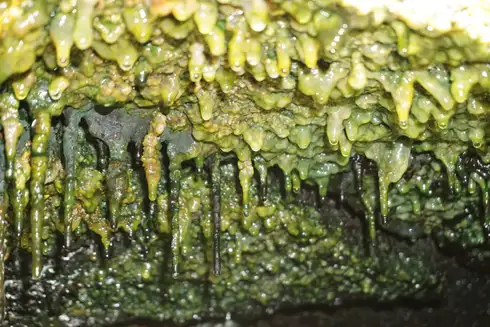Hawaii’s Lava Caves Are Teeming With Bacterial ‘Dark Matter’
Hawaii’s volcanic environments contain a rich array of mysterious microbes, new research this week has found. Scientists say that the islands’ lava caves and other structures created by volcanic activity have unique, diverse, and still uncharacterized communities of bacteria living inside them. The findings indicate that there is much left to learn about life in some of the most extreme conditions on Earth.
本周的一项新研究发现,夏威夷的火山环境中含有丰富的神秘微生物。科学家们说,这些岛屿的熔岩洞穴和火山活动形成的其他结构具有独特的、多样的、仍然没有特征的细菌群落。研究结果表明,在地球上一些最极端的条件下,还有很多东西需要学习。
Researchers at several universities and NASA collaborated for the study, which was published Thursday in Frontiers in Microbiology. They studied samples collected from 70 sites along the Big Island of Hawaii, the largest island of the Hawaiian archipelago. These sites included caves, tubes, and fumaroles, which are openings or vents where volcanic gasses and water can escape. They analyzed and sequenced the RNA found in the samples, allowing them to create a rough map of the bacterial communities living there.
几所大学和美国宇航局的研究人员合作进行了这项研究,这项研究于周四发表在《微生物学前沿》上。他们研究了从夏威夷群岛最大岛屿夏威夷大岛沿线70个地点采集的样本。这些地点包括洞穴、管道和喷气孔,它们是火山气体和水可以逃逸的开口或喷口。他们对样本中发现的RNA进行了分析和测序,使他们能够绘制出生活在那里的细菌群落的粗略地图。
Some of these areas, particularly those with ongoing geothermal activity, are the most inhospitable places in the world, since they are incredibly hot and filled with chemicals toxic to most living things. So the research team expected to find relatively little variety of life nestled within the sites that had these extreme conditions. Older caves and tubes that were formed over 500 years ago, the researchers found, did have greater bacterial diversity. But to their surprise, even the active geothermal vents were filled with a wide variety of bacteria. And compared to the other sites, the bacterial communities in these harsher habitats also appeared to be more complex in how they interacted with one another.
其中一些地区,特别是那些正在进行地热活动的地区,是世界上最不适宜居住的地方,因为它们非常炎热,充满了对大多数生物有毒的化学物质。因此,研究团队希望在这些极端条件下的遗址中发现相对较少的生命种类。研究人员发现,500多年前形成的更古老的洞穴和管道确实具有更大的细菌多样性。但令他们惊讶的是,即使是活跃的地热喷口也充满了各种各样的细菌。与其他地点相比,这些恶劣栖息地中的细菌群落在如何相互作用方面似乎更为复杂。
“This leads to the question, do extreme environments help create more interactive microbial communities, with microorganisms more dependent on each other?” said study author Rebecca Prescott, a researcher at the NASA Johnson Space Center and University of Hawaii, in a statement. “And if so, what is it about extreme environments that helps to create this?
“这就引出了一个问题:极端环境是否有助于创造更多互动的微生物群落,使微生物更加相互依赖?”美国宇航局约翰逊航天中心和夏威夷大学的研究员、研究报告作者丽贝卡·普雷斯科特在一份声明中说。“如果是的话,是什么样的极端环境造成了这种情况?
The bacteria found in these sites also rarely overlapped, meaning that these environments seem to host their own unique microbial worlds, with at least thousands of unknown species left to be identified. One group of bacteria in particular, known as Chloroflexi, might be especially influential, though, since they were commonly found in different volcanic areas and seemed to interact with many other organisms. And it’s possible that they may be an example of a “hub species”—microbes vital to the structure and function of their communities.
在这些地点发现的细菌也很少重叠,这意味着这些环境似乎拥有自己独特的微生物世界,至少还有数千种未知物种有待鉴定。然而,有一类细菌,被称为氯挠曲菌,可能特别具有影响力,因为它们通常在不同的火山地区发现,似乎与许多其他生物相互作用。它们可能是“枢纽物种”的一个例子-对其群落结构和功能至关重要的微生物。
Read more at Gizmodo.com
在Gizmodo.com阅读更多











